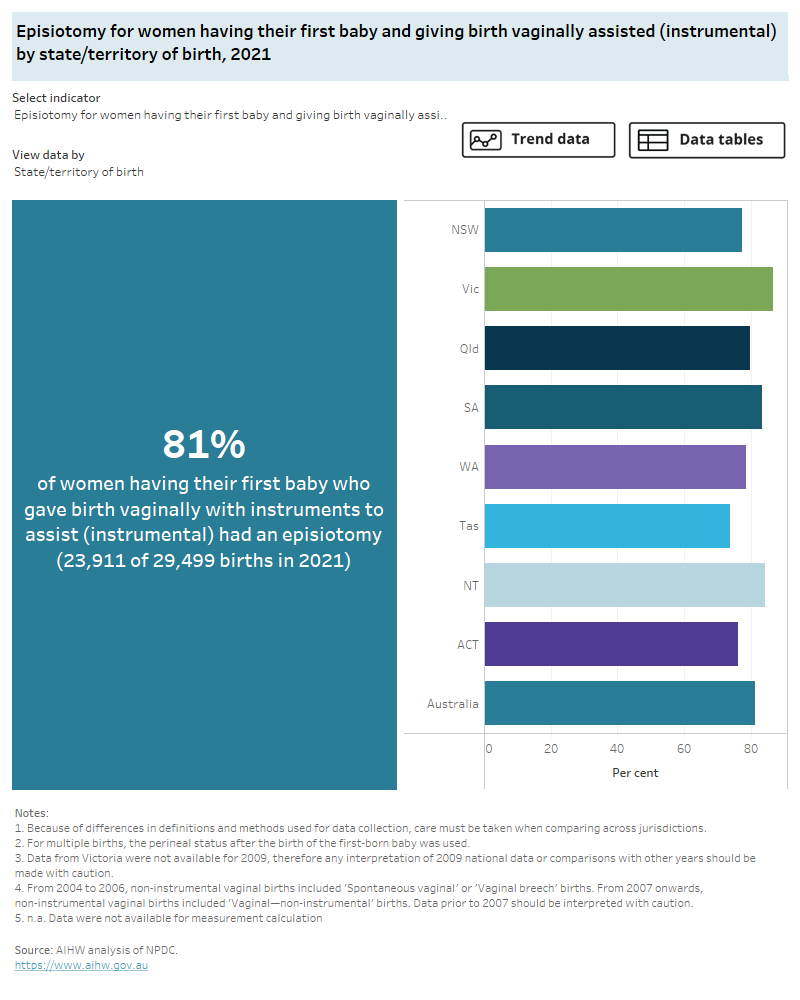Episiotomy
An episiotomy is an incision made in the perineum (the tissue between the vaginal opening and the anus) and vagina to enlarge the vaginal opening (RCOG 2015). This indicator examines the frequency of episiotomy for women having their first baby and giving birth vaginally, either with or without the assistance of instruments. For more information, see Clinical commentary.
Key findings
- In 2021, nearly one quarter of women (23%) giving birth for the first time received an episiotomy in a non-instrumental vaginal birth.
- In 2021, around 4 in 5 women (81%) giving birth for the first time received an episiotomy in an instrumental vaginal birth.
- The proportion of women giving birth for the first time receiving an episiotomy has increased from 16% in 2004 to 23% in 2021 for non-instrumental vaginal births.
- The proportion of women giving birth for the first time receiving an episiotomy has increased from 61% in 2004 to 81% in 2021 for instrumental vaginal births.
The interactive data visualisation (Figure 10) presents data on episiotomy for women having their first baby and giving birth vaginally assisted, by selected maternal characteristics. Select the trend button to see how data have changed between 2004 and 2021.
Figure 10: Episiotomy
Episiotomy for women having their first baby and giving birth vaginally (instrumental), 2004 to 2021.
This chart shows the proportion of women having their first baby with an episiotomy and giving birth vaginally assisted (with instruments), for the current data 2021 and trend data from 2004 to 2021. The proportion of women giving birth for the first time, vaginally assisted (with instruments) who had an episiotomy increased from 61% in 2004 to 81% in 2021. The chart also shows the proportion of women giving birth for the first time, vaginally without the use of instruments who had an episiotomy. This has increased from 16% in 2004 to 23% in 2021.

Clinical commentary
Episiotomy can shorten the second stage of labour, but the consequences of the trauma to the perineum and, potentially to the anus and rectum, need to be balanced against the need for episiotomy. The possible use of episiotomy during a vaginal birth must be discussed prospectively with the woman (ACSQHC 2021).
Evidence suggests that selective use of episiotomy is better practice than routine use of episiotomy and may reduce the level of pain, urinary incontinence, painful sex or severe perineal trauma (Jiang et al. 2017).
Indicator specifications and data
Excel source data tables are available from Data.
For more information refer to Specifications and notes for analysis in the technical notes.
ACSQHC (Australian commission on Safety and Quality in Health Care) (2021) Third and fourth degree perineal tears clinical care standard (2021), accessed 17 August 2022.
Jiang H, Qian X, Carroli G and Garner P (2017) ‘Selected versus routine use of episiotomy for vaginal birth’, Cochrane Database of Systematic Reviews, 2: CD000081, doi:10.1002/14651858.CD000081.pub3.


